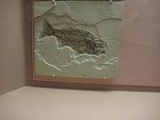
Mioplosus
Encyclopedia
Mioplosus is an extinct genus of prehistoric bony fish that lived from the early to middle Eocene
.
Very similar to today's perch, the Mioplosus is distinguished by its double dorsal fin and pointed teeth. It is thought to have been a solitary predator often attacking fish up to half of its own size. Mioplosus range from 2 to 20 inches but anything over 16 inches is very rare.
This 50 million year old, Eocene-Era fossil fish comes from one of the world's famous Laggerstatten, the Green River Formation in Wyoming. A small portion of the fish fossils from Green River exhibits such fine preservation.
Mioplosus labracoides is believed to have been a voracious predator among the Green River fish fossils. Failure to find its numbers in mass mortality leads to further conjecture that it was a solitary hunter. A member of the Family Percidae, it has numerous relatives in Northern Hemisphere fresh water as well as fossil relatives in Asia, Europe and New Zealand. It is known as a predatory species as determined from its many pointed teeth, and the fact that several have been found with fish lodged in its throat. It may be related to the modern-day pike of the genus Stezostedion.
Distinguishing features include double dorsal fins and a fan-like tail. Mioplosus is uncommon in the Green River formation, especially the fish of this size.
Eocene
The Eocene Epoch, lasting from about 56 to 34 million years ago , is a major division of the geologic timescale and the second epoch of the Paleogene Period in the Cenozoic Era. The Eocene spans the time from the end of the Palaeocene Epoch to the beginning of the Oligocene Epoch. The start of the...
.
Very similar to today's perch, the Mioplosus is distinguished by its double dorsal fin and pointed teeth. It is thought to have been a solitary predator often attacking fish up to half of its own size. Mioplosus range from 2 to 20 inches but anything over 16 inches is very rare.
This 50 million year old, Eocene-Era fossil fish comes from one of the world's famous Laggerstatten, the Green River Formation in Wyoming. A small portion of the fish fossils from Green River exhibits such fine preservation.
Mioplosus labracoides is believed to have been a voracious predator among the Green River fish fossils. Failure to find its numbers in mass mortality leads to further conjecture that it was a solitary hunter. A member of the Family Percidae, it has numerous relatives in Northern Hemisphere fresh water as well as fossil relatives in Asia, Europe and New Zealand. It is known as a predatory species as determined from its many pointed teeth, and the fact that several have been found with fish lodged in its throat. It may be related to the modern-day pike of the genus Stezostedion.
Distinguishing features include double dorsal fins and a fan-like tail. Mioplosus is uncommon in the Green River formation, especially the fish of this size.
See also
- Prehistoric fishPrehistoric fishPrehistoric fish refers to early fish that are known only from fossil records. They are the earliest known vertebrates, and include the first and extinct fish that lived through the Cambrian to the Tertiary. The study of prehistoric fish is called paleoichthyology...
- List of prehistoric bony fish

